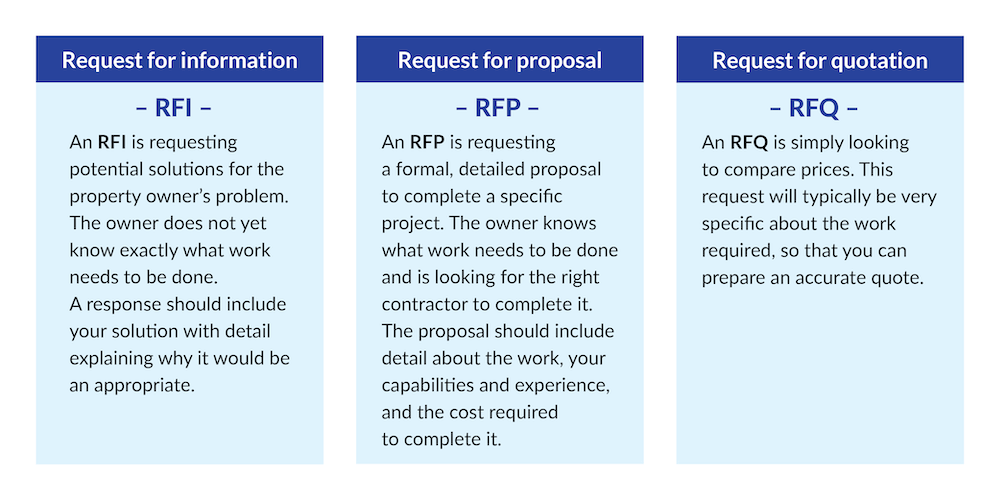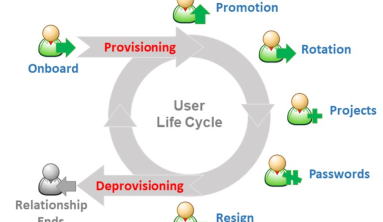RFIs and RFPs are used at different points in the pre-development phase of a project. Both types of requests are looking for solutions to a problem, but the response to each one will be very different. In this article, we’ll compare RFI and RFP, and see how each is used in projects (IT, construction...). Oh, and don’t forget about an RFQ…we’ll see how it differs from the others.
RFI vs. RFP: What’s the difference?
A request for information (RFI) is used when the owner wants several contractors to provide potential solutions, while a request for proposal (RFP) is used in a bidding process to solicit offers for a project.
Knowing when to use each document is key to knowing where the owner is in the buying experience. Are they trying to understand their options, or have they landed on one and need to hire the best contractor to implement it?

An RFI is general, asks fewer questions, and is more open to contractors providing solutions to a given problem. An RFP is more specific, asks a lot of questions regarding qualifications and experience, and is generally more price-focused.
Request for information (RFI)
When a project owner has a problem they need fixed but don’t know the best way to address it, they may issue a request for information (RFI) to gather possible remedies from contractors.
There usually isn’t a design or any documents other than a brief description of the problem. The request will include a few open-ended questions intended to get information from a potential vendor.
For example, say that a Website owner needs to build the SEO tools to improve their website ranking. They’ll ask retaining SEO vendors to answer an RFI for their potential project.
In this type of proposal, contractors will often suggest ways to fix the problem and provide information about their company in hopes of convincing the owner to choose them. Pricing may or may not be included, or a rough budget may be given.
For the owner’s SEO project example, let’s say there are three companies replying. One proposes a separate Website with backlinks to main Website, one a dedicated SEO tool, and the third suggests using 3-rd party services. They will each include some information about their proposed solution and how it’s best for the owner’s situation.
RFIs are usually pretty informal and don’t take long to respond to. You may receive an email from a project owner with a few questions about how you’d tackle their issue. Once an owner receives the responses, they may select a contractor or vendor at that time, choose not to do the project, or they may move on to a more detailed proposal type.
RFIs aren’t heavily focused on price or the capabilities of the contractor or vendor. It’s more of a chance for the owner to receive several solutions to his problem and make a choice on which one he feels most comfortable with. In our SEO example, the owner may feel that both the tools and 3-rd party services are possible solutions he is comfortable with. So, he’s going to invite both companies to submit a response to an RFP.
Request for proposal (RFP)
Once an owner has an idea of the project they’d like to contract out, they can send out a request for proposal (RFP) from several contractors. The owner usually has some drawings or sketches, prototypes showing the work that needs to be done at this point. This is important, as the contractors need to be providing a proposal for the same scope of work.
The RFP process will typically involve some prequalification of the contractor to determine their ability to get the job done. Compared with RFIs, RFPs have more detailed questions about the contractor’s experience and skills, and responses are sometimes scored to help owners choose the best one for their project. Contractors may be asked to provide references, list past projects, or provide bios or resumes for their main staff.

Unlike an RFI, the process of submitting an RFP is more formal. The owner may pose several questions to contractors, to gauge their experience and trustworthiness. The more complex the project becomes, the more questions the contractor will be required to answer.
One of those deciding factors is often pricing. Contractors may propose possible solutions, but generally there is a prescribed design that the owner wants the contractors to stick to.
In the example, assume the owner asks both SEO companies to provide a response to his RFP that includes prototypes they are proposing, pricing, five references, staff resumes, and proof of insurance. He will use all of this information to weigh which contractor to select. Depending on what qualities he values most, he may or may not select based on price.
If the project is built by a public or government entity, however, the agency is often required to choose based on the lowest bidder.
Request for quotation (RFQ)
A request for quotation (RFQ) is related, but much more price-driven than the other two proposal types. The owner usually has selected the solution they want to use and just wants to know how much it will cost. There aren’t a lot of questions about qualifications to answer, as it’s more about pricing, payment options, and delivery timelines.
An RFQ is typically used when the owner is purchasing standardized products or services, or has a tightly specified scope of work.
For example, if our owner decided to buy the tools for the SEO himself, he would send an RFQ to a few SEO tool suppliers requesting the cost. He would need to specify which tools he wanted to use. The suppliers would send over their quotes, and the owner would purchase the tool based on the best price.
RFI vs. RFP: Choose the right format
Now that you know the difference between these types of proposals, you can gauge where your potential customer is in the buying process.
Are they just starting out, searching for solutions? A quick RFI with a few basic questions is probably being sent out to several contractors, so it’s generally a good idea not to spend too much time crafting a good response. In the end, they may choose not to pursue the project at all.
If they are further along and have some drawings or specifications, and are asking about qualifications and experience, then they will probably be sending out an RFP.
However, if they are just looking for a specific material and need multiple quotes to compare pricing, then answering an RFQ is the best way to go.
Keep these different proposal types in mind as you research open opportunities. You now know how much time to invest in each one, based on the amount of information requested and where the owner is in the purchasing process.





